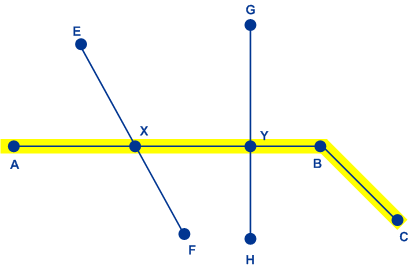Directions
|
Option optionName Parameter |
Description |
|---|---|
|
Show Distance ShowDistance Option.ShowDistance |
Specifies whether to return the distance for the route.
|
|
Return textual directions ReturnRouteDirections Option.ReturnRouteDirections |
Specifies whether to return turn-by-turn directions for the route. This option is enabled by default.
|
|
Return segment geometry ReturnSegmentGeometry Option.ReturnSegmentGeometry |
Specifies whether to return a set of latitude/longitude points that represent a geometry for a segment within a route. The segment geometry is used to create the route geometry. The output of this field is shown within the RouteDirections output field. For more information about route geometry, see What is Route Geometry?. |
|
Return route geometry ReturnRouteGeometry Option.ReturnRouteGeometry |
Specifies whether to return a set of latitude/longitude points that represent a route geometry. The route geometry can be used to create a route map and to perform analysis on the route. If you choose to return route geometry, select the type of route geometry to return. One of the following:
|
|
Default language DefaultLanguage Option.DefaultLanguage |
Specifies the language in which Get Travel Directions should return directions. One of the following:
|
|
Show Time ShowTime Option.ShowTime |
Specifies whether Get Travel Directions should return the time it takes to follow a direction within the route.
|
|
Show Primary Name ShowPrimaryNameOnly Option.ShowPrimaryNameOnly |
Specifies whether Get Travel Directions should return all names for a given street in the directions or if it should return just the primary name for a street.
|
What is Route Geometry?
A route geometry is a series of latitude/longitude points that form a route. A route geometry can be as simple as a single point, such as a route that starts and ends on the same street segment:

Since the starting point is always known the route geometry in this very simple example could be just the end point. So if A is the starting point, the route geometry could be the latitude/longitude of point B.
In a more complex route geometry involving multiple route segments there can be several points in the route geometry. Consider the route highlighted below which starts at point A and ends at point C, traveling through intersections X, Y, and B:

In this route, the full route geometry would consist of the latitude/longitude of points A, X, Y, B, and C. Note that you can control which points to actually return and may choose to include all points in the route geometry or just the end points of each route segment. In the above example, the end points are B and C, since A to B is one route segment and B to C is another.
